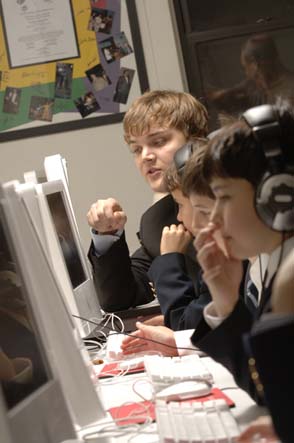
Description: Constructivism and Technology in Action
Image copyright: http://www.browning.edu/images/photos_width/294/computers.jpg
The constructivist approach emphasizes problem-solving, individualized learning, student interaction, differentiated instruction, discovery learning and teacher as facilitator. All of these likewise take place when technology is used to educate students. The picture above illustrates the fusion of technology and constructivism. Students are interacting to solve a problem while using technology. The constructivist approach is a research-based method of instruction that is widely accepted and effectual. Utilizing technology to teach via the constructivist approach can be implemented using a variety of strategies, several of which can be viewed at the Integrating Technology in the Curriculum website (see Links).
One of the more current developments which combines constructivism and technology is the use of distance learning. Distance learning occurs when students complete their coursework with the use of technology. Students and teachers communicate by accessing an online network such as Blackboard, Moodle, or a similar network. Distance learning is a prime example of the teaming up of technology and constructivism. Research indicates that there are several advantages to this method of delivery, but also suggest that in order for this to be effective the following must be present: teachers need to be taught to be facilitators, students need to be trained to use this learning method, assessment should be embedded within the learning process, learning should be problem-based, and more than one approach should be used for students to demonstrate content mastery (Herring, 2004).
Another example of the use of technology is communication and interaction among students and between the teacher and students through classroom blogs or through classroom websites. Students can access a variety of resources, many of which are interactive, through a class websites. One of the most recent websites available to teachers at no cost is Wikispaces. At Wikispaces, for instance, the teacher can write the first line of an essay, and each student can log on to the class Wikispaces page and can add on to the essay. Students can even edit what other students have added. Other websites allow students to create a variety of projects online, all of which can be shared with their classmates. This exemplifies what constructivism brings to the classroom.
The amalgamation of constructivism and technology is an important issue for todayís classroom teacher, particularly since there has been great emphasis put on moving away from a heavy reliance on simple comprehension and toward the studentís ability to engage in higher order thinking. If a teacher understands that the use of technology in the classroom is more than just a way to provide students an alternative mode of communication and is instead a valuable way to effectively use the constructivist approach to teaching, it will perhaps provide the impetus for the teacher to take full advantage of all professional development opportunities available that deal with technology.
Sources:
Rakes, G.C., Fields, V.S., & Cox, K.E. (2006). The influence of teachers'technology use on instructional practices. Journal of Research on Technology Education, 38(4), 409-424.
Herring, M.C. (2004). Development of constructivist-based distance learning environments: A knowledge base for K-12 teachers. The Quarterly Review of Distance Education, 5(4), 231-242.
